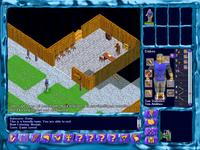| |
Site Navigation
Main
News
Forums
Games
Games Database
Top 100
Release List
Support Files
Features
Reviews
Previews
Interviews
Editorials
Diaries
Misc
Download
Gallery
Music
Screenshots
Videos
Miscellaneous
Staff Members
Privacy Statement
|
|
City of Villains Beta - A Newb's-Eye View
Wildefire, 2005-10-19 
I've never been a big comics fan, and I've always preferred High Fantasy to modern settings in the games that I play, so I was never really interested enough in City of Heroes to try it out. As I met other people who enjoy MMORPGs, though, I kept hearing good things about the game, so when I learned I had an opportunity to take part in the beta tests for CoH's evil counterpart, City of Villains, I jumped at the chance. What follows are my observations from the first few days of playing City of Villains as a total newbie to NCSoft's hit franchise.
Choose Your Own AdventurerCity of Heroes players often gush about the game's deep character creation system, and City of Villains apparently carries on the tradition. Never before have I seen a game that gave you such comprehensive control over your avatar's looks and initial abilities. After choosing a home server for your new villain, the first things you choose are his or her archetype and origin. The archetype is your character's class, and the origin is kind of a subclass that determines the source of your evil powers, and the abilities available to you. Next, you choose your power sets and your initial powers. In City of Villains, powers are everything- it is only by using your powers that you can fight, flee, or heal. Power sets are fixed collections of powers that you will eventually be able to unlock within the game. You must pick two power sets- a primary and a secondary- and you must pick your initial powers from a limited list of powers in those sets.
Once you've decided what your villain can do you get to tackle the fun stuff- how your character looks! You pick between three body types, (male, female, or the apparently all-male 'huge' variety), and then choose a build (height, shoulder width, leg length, etc.). There are templates for different builds (slim, average, athletic, heavy), but you can tweak each of the parameters individually if you like. Finally you design your avatar's head, face, and costume. There are so many options on the costume screen (which includes facial features) that there's a randomize button if you just want to take your chances. There is no concept of 'armor' in this game; the whole purpose of costume design is to just make your villain look damn good.
Get Out Of Jail, Flee
|
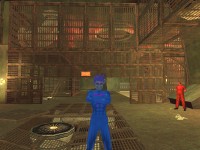
You can't play as many RPGs as I have without learning a little something about breaking out of jail.
|
As in all great RPGs, your first task when logging into City of Villains is to bust out of jail. You'll meet some non-super inmates who'll help you escape as long as you provide them with the drugs and weapons they need. These initial errands serve as a tutorial that instructs you how to acquire and perform missions (quests), and to use your powers and the minimap. In City of Villains, quest givers are called contacts, and it is by performing duties for these contacts that you meet other contacts and progress through the story. The heads-up display has a contacts menu that lists any contacts you currently have a relationship with. When you select a contact on the list, a little icon appears on your compass, which indicates the direction you'll have to go in order to find that person. There is also a mission menu that works similarly; selecting your current mission (usually) places a blip on your compass which shows you where the mission objective lies. In addition to the compass, City of Villains also provides a nifty customizable minimap that marks important locations and people on your map; selecting markers on the map places a blip for that place or person on your compass. After playing Guild Wars and now City of Villains, I really wish more games did this sort of thing. I mean, do you know anyone who plays World of Warcraft that doesn't rely on Thottbot or Allakhazam for quest and NPC locations?
Missions AccomplishedAfter escaping from the big house and kicking some butt (for the sake of the tutorial), your villain is escorted to Mercy Island where you'll get your first real missions. (It is also in Mercy Island that you meet arbiters who grant you with powers and enhancements as you level up.) Mercy Island is a large open area crawling with other players and various civilian scum. Like Guild Wars, most missions in City of Villains are instanced; when you enter a mission, you and any team mates you might have are the only players in that area. Mission entry points are scattered all over the larger public areas, and your compass leads you to them at the appropriate times. Unlike Guild Wars, however, the instanced missions in City of Villains are automatically tuned to suit your team. For example, I completed one mission solo that involved clearing a number of very large snakes out of a cave. I faced about 30 snakes in all. Later that day, I joined a group of six other players to help them out with the same mission- only this time there were hundreds of snakes! It was really impressive- when we all reached the end of the cave, where most of the snakes were congregated, our team chat was briefly peppered with bleeps (thanks to the chat filter), but we ultimately prevailed. Due to this tuning, casual players can have pretty epic encounters just running ordinary missions.
|
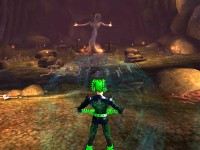
Snakes. Why'd it have to be snakes?
|
While you might have multiple NPCs in your contacts list, you can only have one active mission at a time. Contacts that offer multiple missions will sometimes give you a choice of which mission to take first. Later on in the game, when you leave Mercy Island for the rougher, bigger Port Oakes, you'll be given access to a newspaper (accessible from your contact list) which lists side missions appropriate to your level- much like the side mission system in Freelancer. Additionally, some missions are timed, and if you fail to complete the mission before time runs out, you will not get another opportunity to complete it. (I learned this the hard way by logging out at bedtime when I had a timed mission, thinking the timer would just resume when I logged back on. I was wrong, and I failed the mission as a result.) You can, however, assist other players in completing missions that you previously completed or failed, although you won't get mission credit for them. Also, although you can personally only have one mission active at a time, if you are teamed with other players, any of their active missions will temporarily appear in your mission menu so that you can select them to update your compass.
There Is No LootOne thing that's very different about City of Villains is the fact that there are no weapons, armor, loot, potions, or money in the game- which also means no encumberment, bag slots, banks, or (hopefully) farmers! When you kill opponents, you occasionally obtain enhancements or inspirations from them, but that's it aside from XP. So how do you equip yourself without armor upgrades? Well that's where enhancements and inspirations come in. As you level up, you get the option to add enhancement slots to your various powers. For example, you might have an offensive power that casts a fireball, and if you have a free enhancement slot you could drag in an enhancement that adds a damage bonus to every cast. Eventually you can add multiple slots to your various powers, and there are many possibilities for customizing your powers as a result. This is a very deep system (you can even, to a limited extent, combine identical enhancements to improve their effects) and different players have different priorities when upgrading their powers. Inspirations are single-use power-ups, like scrolls in other games, which you can easily cast in a pinch for some extra HP, energy, or defense. Without an inventory, there are no true quest items either, but in certain missions you will uncover 'clues' which might be information or even virtual objects required to complete the task. These are added to your clues menu and automatically removed once their purpose has been served.
As mentioned earlier, costumes are purely cosmetic, and you can acquire more throughout the game by visiting specialty shops in the various public areas. You can have multiple costumes at your disposal and swap through them easily via a special menu. You can even get a sort of virtual plastic surgery and alter your character's looks- you can't change your height or body type, but you can alter almost any other physical feature. There is no money in the game, but if there are stores there must be some kind of currency, right? Yes, and that currency is infamy. Whenever you complete an objective you accrue a certain amount of infamy, which you can then spend at various stores and merchant NPCs. In addition to the aforementioned stores, many NPCs offer enhancements and inspirations for sale.
Power To The People
|
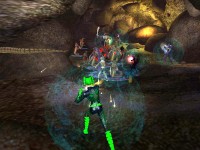
My team delivers a fearsome smackdown to Mercy Island's reptilian population.
|
Aside from the powers that you choose during character creation, all villains have some 'inherent powers' such as the ability to fist-fight, or to run really quickly. You must execute every power individually using the 'tray' (hotbar) at the bottom of your screen or by using the appropriate hotkey. There is no 'auto-attack' like in other games; if you want to fist-fight with somebody you need to execute every punch individually. The tray indicates when powers are out-of-range, and if you try to use a power when this happens, the power will remain queued until you either get closer to your target or you cancel the power.
Odds and EndsHere are some things that I've not yet been able to experience first-hand, either because the features aren't yet available, my villain hasn't reached a high enough level, or I haven't found enough people to share in the fun.
- Supergroups (guilds). A supergroup is more than just a random bunch of players. Supergroups can construct their own bases (which can be raided by other players, at your group's consent), and acquire unique "items of power" which grant your group special abilities. Some of these items are so rare that there is only one per server.
- PvP. Player-versus-player combat is limited to special PvP zones, consensual base raids, and arena matches. Arenas offer all manner of PvP combat: one-on-one, team-on-team, factional (villains can fight heroes from City of Heroes), or free-for-all (villains and heroes allowed, anyone's a target). You join an arena fight by selecting the desired match type and time at a kiosk; you are then invited to join the battle when the match is scheduled to begin.
- Twinking Revisited. If you're a high-level player with low-level friends (or vice versa) you have two options for adventuring with them without suffering the effects of the level gap between you. A high-level villain can invite a low-level friend as a lackey. As long as the two players are teamed in this way, the lower-level villain will operate at the level of a player only one level below the inviting party. The lackey will not gain any new powers during this time, but any existing powers and stats will be elevated to a strength commensurate with the virtual level. Conversely, a low-level villain can invite a high-level counterpart to act as a malefactor. Malefactors get nerfed down to their teammate's level, but still get to use all their existing powers (albeit at limited effectiveness).
- Strike Forces. Strike forces are challenging team missions that can range from two to ten hours in length. The game's developers understand that not all players have ten hours in a row to do something like that, so teams can choose to pause a strike force mission at any time, get some sleep, and then resume where they left off at a later date.
- Death Penalties. When you die, your body is automatically transported to the nearest hospital, and you'll have to run all the way back to your mission location and try again. After level 9 however, an additional penalty is imposed: XP debt. The game will charge you a certain amount of XP, and 50 percent of any XP you gain is applied toward that amount until you pay it off. I presume the amount you are fined increases with your level, but I don't know if any other variables are involved. I like this system better than outright XP loss; at least you're allowed to make some progress while you're paying off your XP fine.
- Flight. You're super, and eventually you'll learn to fly. I've never seen a flying player yet, so I imagine you don't learn this until fairly late in the game. I also expect it makes PvP battles rather interesting.
The Good The Bad and the Bugly
|
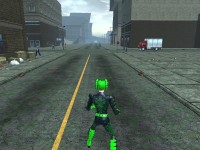
What is this, Grand Theft Auto: Port Oakes? I shoulda brought an UZI or an AK.
|
In this late stage in the game's development, some definite strengths and weaknesses are evident. Additionally, there are still some significant bugs that will hopefully get squashed before the game goes gold.
- Good: Graphics. With the amazing amount of character customizability, you'll probably not ever see another villain like your own. Also, in the open environments, the draw distances are quite impressive, lending a further sense of reality to the environment. Unfortunately (and inexplicably) the graphics don't seem detailed enough to merit the system resources they currently require. Hopefully some pre-launch optimization will remedy this matter.
- Good: Immersion. The areas I've explored have been large, gritty, populated urban landscapes that really give you a sense of menace and apprehension. In the Port Oakes region, computer-controlled cars and trucks even patrol the roads. The game also does a good job of making you feel super; you don't need fancy armor and weapons- you've got super powers! Using your Sprint power, you can run faster than players in almost any other MMORPG, and you can jump high and far enough to clear fences and land atop tall objects. My only complaint here would be that so far I don't really feel like a villain. In most of the missions I've done up to this point, my enemies have been pretty bad guys themselves. Heck, some of my deeds have almost been, well, heroic. I'm not sure I want missions where I have to kidnap babies or kick puppies, but I wonder whether the game will be able to deliver a true, yet palatable, sense of villainy.
- Good: Play Your Own Way. By scaling mission difficulty based on the number of people in your party, City of Villains manages to provide both solo and team players a challenging, and rewarding experience. Also, by providing a way for teams to resume strike force missions at their leisure, the game allows more casual players access to high level content that they might not otherwise see.
- Good: Interface. While the game's UI does not appear to be customizable via external add-ons, all heads-up display elements are draggable and well designed. For example, you can set up different tray configurations so you can have a variety of power sets for certain circumstances, and easily switch between them. You can also show or hide certain elements of various components at will, or hide them altogether. Additionally, the compass and on-screen distance/position indicator make finding mission objectives and NPCs a breeze.
|
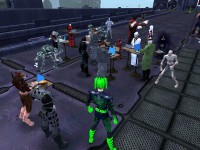
An impromptu Internet cafe.
|
- Good: Emotes. City of Villains provides plenty of cool new emotes- some even involving props. For example, when you execute the laptop emote, a little table with a notebook computer appears, and your character begins feverishly typing on it. Mastermind characters can even instruct their minions to perform emotes. While most of these emotes are cool and lots of fun, the dance emote is lame. After World of Warcraft and Guild Wars, a dance emote had better be a little more sophisticated than putting your avatar's arms in the air and making it hop from side to side. Only slightly better is the boombox emote, which produces a portable radio at your villain's feet and causes the character to do the very dance that all white people the world around are genetically programmed to know.
- So-so: Sound and Music. What little mood music there is seems to range from prefab metal to techno. It's fine, but there's not very much of it, and none of it's really memorable. One sort of odd thing, though is the lack of many sound effects. During battles, the only sounds you hear are those of the various powers you and your foes are doling out. No grunts, shouts, or vocalized exclamations of anything at all. I never thought that the lack of sound effects could be distracting, but it is.
- Bad: Performance Anxiety. If you're wondering whether your 'mature' gaming system is going to be capable of playing this game, you have reason to worry. I played City of Villains on both of my gaming computers (a laptop and a desktop), and got pretty poor performance on both. The native resolution on my laptop (2.1GHz Pentium M, 1GB RAM, ATI Mobility Fire GL 128MB, 7200RPM HD) is 1600x1200. I'm able to play both World of Warcraft and Guild Wars at that resolution at a solid 30 frames per second. With City of Villains, however, that resolution was completely unplayable. Even when I bumped down to 1024x768 I was only getting 8FPS just standing still. I ended up having to drop down to 800x600 with all video options turned all the way down simply to get 26FPS. Now if you're only getting 26FPS during normal play, you're really going to be hurting during PvP and team missions, because all those particles from the various power animations will slow your system down considerably- you're gonna feel like you're playing Myst rather than an interactive real-time game. Results were slightly worse on my desktop (2.0Ghz Pentium 4, 1GB RAM, ATI 9800 Pro 128MB, 7200RPM HD), where I got a maximum of 24FPS at 800x600 with all settings turned down. Luckily you don't miss out on too terribly much by cutting the video effects (see my screenshots for a comparison), but battles aren't as impressive without the eye candy. Note that veteran City of Heroes players were also complaining of poor performance, so even though City of Villains is based on the same engine, it's different enough to require a beefier system.
|
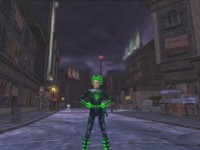
800x600, all graphics options turned up.
|
|
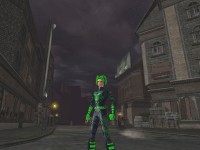
800x600, all graphics turned down. The character is a jaggier, and some of the background detail (especially the billboard) is less obscured by lighting effects.
|
- Bad: Districts. Most MMORPGs segregate their populations across servers; characters created on a given server can only play with/against characters on the same server, and communication across servers is generally not possible. City of Villains is no exception, however it further divides the server's population into virtual districts, where only a subset of players currently logged onto that server can play together. This is done for population control in heavily trafficked areas, but doesn't seem to be implemented very well. For example, when you complete a mission, an Exit button appears in your heads-up display that you can click to be immediately teleported out into the public area. This is very nice, except if you are in a team, your team can be disbanded and players may be delivered into different districts, without any way to get back together. The work-around to this is for all team members to run back to the mission's starting area, and decide upon a district to enter (you are presented with a list when you do it this way), and then all choose the same one. However, this appears to be the only time you have a choice of which district to enter. Guild Wars has a cool solution to this; in Guild Wars you are randomly placed in a district when you log in or use the map teleportation method, but once teleported, players can choose another district to enter from a drop down menu. City of Villains does not appear to have a workaround for this at the moment, and I feel it's a sorely needed option.
- Bad: Repetition. In the Mercy Island area, I completed at least five quests which all involved going to some area and killing lots of giant snakes. In each case, the snakes all looked the same (only two character models, and a couple different color schemes), and in three of those missions, the actual mission level (a tunnel) was identical, even though each mission was supposed to occur in a different part of town. When also considering the non-snake missions, there was a fair amount of level design and mission objective repetition all around. That I would have encountered so much reused content within my first few levels does not inspire much confidence. Perhaps they were reserving all their resources for high-end content, but only time and experience will tell.
- Bad: Enemy AI. Computer-controlled enemies are not very smart, and behave erratically. I encountered numerous occasions where I attacked a foe who was standing right next to numerous other mobs who didn't even budge as I was taking out their buddy. At other times I drew aggro from many enemies simultaneously when I thought I was at more than a safe distance from them. Also, sometimes enemies will turn and run in the middle of a fight. Now I've played other games where enemies do this to save their bacon if their health is low, or to yell for reinforcements- but that's not the case here. Not once did I see a mob who ran when its health was actually dangerously low, and I never saw a runner aggro other mobs in the vicinity.
- Bug: Graphics Glitches. Both of my computers have ATI graphics chipsets, and on both systems I had to install the Radeon 5.9 drivers in order to play the game. Without that version, I got the "split screen" issue, where the bottom third of the screen was completely static, and only the upper two-thirds showed any animation. Other ATI users have encountered even more severe issues. (Hmm, starting to wonder if there's more than just marketing behind that Nvidia logo they show when the game starts up?)
- Bug: Loading Screen Hangs. About one out of every five times I entered a mission, the loading screen would appear, but the progress bar never updated, the mission never loaded, and I ended up having to kill the game's process in the Windows Task Manager. Many other players complained of this issue... once it even happened to my entire team when we were attempting to enter a mission, but another time I was the only one affected.
Wrap It Up Already!Though I've only spent a few days in the City of Villains, I'm impressed enough by what I've seen to get over my hang-ups about comics and modern day settings to give this game a spin when it hits retail. Cryptic has done a fine job of providing a compelling gaming experience for players of different kinds, and in successfully innovating in the MMORPG genre. I really hope that they can optimize the game's performance though, and that the missions get less repetitive as your character progresses and as new content is added.
|
|




